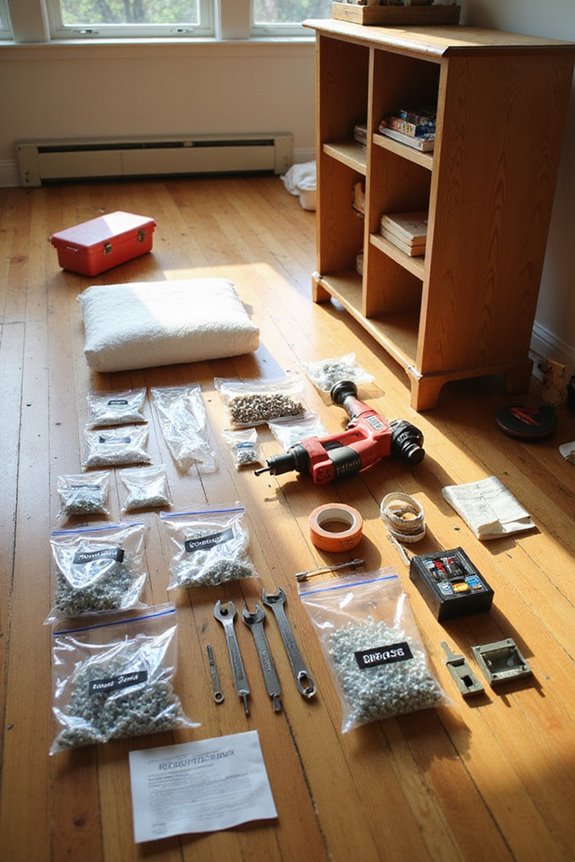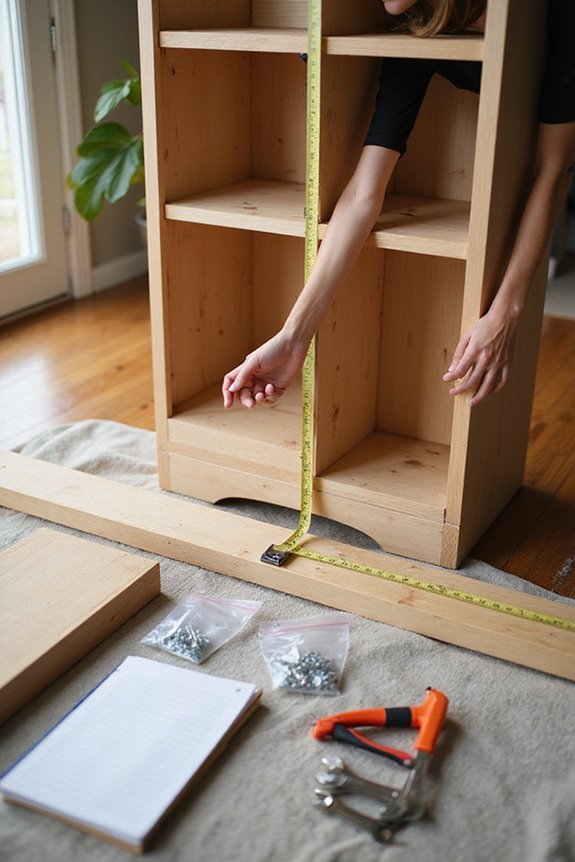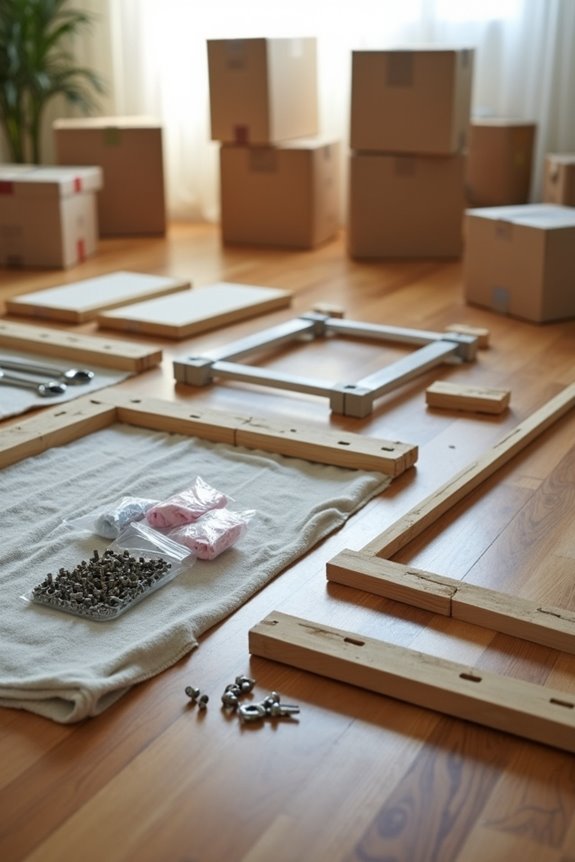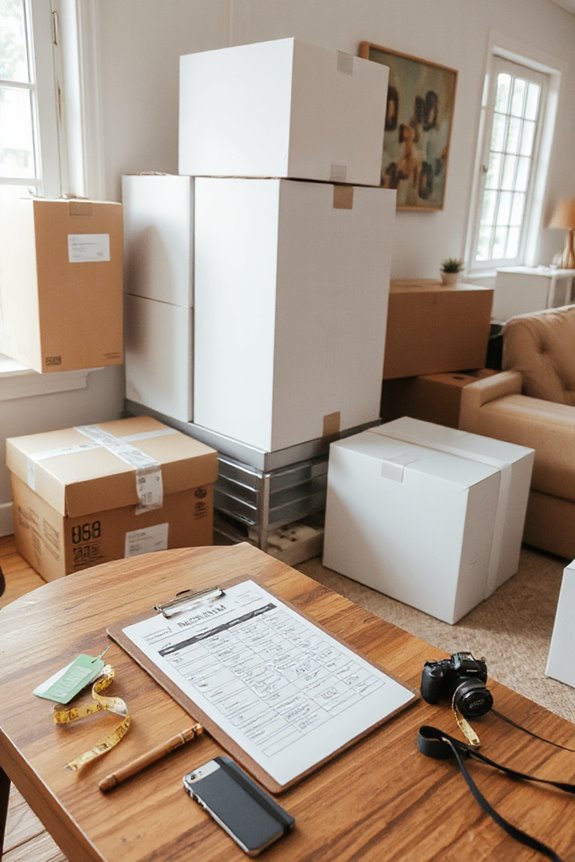Disassembling furniture for a move? It’s easier than it sounds! First, gather your tools—screwdrivers, an Allen wrench, and maybe even a rubber mallet. Clear the space around your furniture. Start by removing cushions and emptying drawers. Measure everything, from heights to doorways, for a smooth fit in your new place. Can’t forget about labeling the parts and hardware! Ready to tackle it all? Stick around, and you’ll learn some more nifty tips!
Key Takeaways
- Clear surfaces to remove cushions and empty drawers before starting disassembly for easier access.
- Use appropriate tools like screwdrivers and rubber mallets for safe and efficient disassembly.
- Label all removed parts and hardware in organized bags to simplify the reassembly process.
- Wrap disassembled furniture pieces in moving blankets to protect them during transportation.
- Measure doorways and hallways to ensure all pieces fit through when moving to the new location.
Tools and Preparation

When you’re gearing up to move, having the right tools on hand can make a world of difference—think of it as your disassembly toolkit! You’ll need essential items like screwdrivers, Allen wrenches, and a good wrench set. These tools will help you tackle anything from flat-packed furniture to bolts and nuts.
Now, let’s talk workspace organization! Make sure to clear your area so you won’t trip over stray boxes or tools. It’s a good idea to use protective materials, too—bubble wrap can keep your pieces safe during the move. Consider using modern storage ottomans to help organize your items efficiently as you pack. Why not label everything as you go? It makes reassembly a breeze! So, are you ready to plunge into and get your furniture packed up? Let’s do this!
Measuring and Assessing

You’ve got your tools and workspace ready, so now it’s time to tackle measuring and evaluating your furniture! Start by using measurement techniques to check the height, width, and length of each piece. Don’t forget to take note of any fragile components that might need special handling—those will give you a headache if not carefully considered!
Next, measure your doorways and hallways. Can your favorite sofa slip through that narrow passage? Include trim and molding in your calculations for accurate clearance considerations. Make sure you also account for any turns and landings that could be tricky. Recording these notes is key! So, grab a notepad or your phone and start measuring—it’s like a scavenger hunt, but with more tape! Additionally, consider the dimensions and seating capacity of your furniture to ensure it fits comfortably in your new space without overcrowding.
Disassembly Process

Ready to plunge into the disassembly process? Let’s get cracking! First up, clear off all surfaces—remove cushions and empty drawers. This makes it easier to work and keeps everything clean. Next, grab your tools; you’ll need screwdrivers and maybe a rubber mallet for those stubborn joints.
Now, start with the legs or any support structures—that’s where many furniture types begin their transformation. Use those disassembly techniques wisely! Don’t forget to label what you remove; trust me, future-you will thank present-you. For sectionals, find and disconnect connectors. It can feel like a puzzle! Modular designs like sectionals often feature connectors that make disassembly straightforward. Wrap everything up securely in moving blankets, so your treasured pieces aren’t rattling around during transport. Ready to organize and tackle the next steps?
Handling Fasteners and Hardware

Handling fasteners and hardware during furniture disassembly can feel like solving a mystery, but don’t worry—you’ve got this! First, identify those fastener types. Are you dealing with screws, bolts, or clips? Grab a screwdriver, socket wrench, or pliers as needed. Next, organize your hardware! Use labeled bags or tape to keep track of what’s what. You’d hate to mix up bolts from different pieces, right?
Oh, and don’t forget to snap photos! This way, you’ll have a visual guide when it’s time to reassemble. Remember, apply gentle pressure when loosening stubborn fasteners. See? It’s not so intimidating when you’re prepared! With a little planning, you’ll master hardware organization and tackle that move with ease!
Protecting and Packing Components

When you’re getting ready to move your furniture, protecting and packing the components is key to ensuring everything arrives in one piece. Start by using bubble wrap for fragile parts like glass panels and mirrors. Who wants a shattered mirror in their new place, right? For larger surfaces, moving blankets or furniture pads work wonders to prevent scratches.
Remember to secure everything with packing tape to keep the cushioning materials in place! Don’t forget those vulnerable corners; corner protectors can be a lifesaver. Wrap individual pieces separately to avoid unwanted scratches from neighbors during transport. And hey, label every part clearly! This way, you’ll avoid that “where does this go?” panic later. You’ve got this—happy packing!
Reassembly and Final Tips
After you’ve carefully packed and protected your furniture’s components, it’s time for the exciting part—reassembly! First, gather your tools—like screwdrivers and power drills—ready to tackle this challenge. Need help? Don’t forget to consult those assembly instructions!
Start by sorting and organizing your parts in labeled bags. This will save you from the dreaded “where’s that screw?” moment.
As you reassemble, use those reassembly techniques you’ve learned, and remember to work in stages. It’s easier that way!
Don’t skip the final checks: Is everything stable and level? Did you miss any parts? Test functionality, like opening drawers. With a bit of patience and a positive vibe, you’ll have your furniture ready to shine again!
Transporting Disassembled Furniture
Transporting disassembled furniture can feel like a puzzle waiting to be solved! To kick off, use heavy-duty moving boxes for smaller parts—this guarantees transportation safety. Don’t forget to keep screws and bolts in labeled, sealed bags. It’s easier to find them later, right?
Now, when loading the truck, place flat, heavy pieces at the bottom. Trust me, this reduces shifting and keeps everything stable! Layer lighter items on top and avoid stacking fragile pieces.
Lastly, keep your tools handy! You might need them for any last-minute disassembly techniques. Wrap each piece with furniture blankets to protect those stunning finishes. It’s all about guaranteeing everything arrives intact—so let’s puzzle this out together! Ready to tackle the move?
Professional Assistance Options
Packing up your home can feel overwhelming, right? That’s where professional assistance comes in handy! Imagine having experts handle the furniture assembly and disassembly for you—sounds like a dream, doesn’t it? Hiring professionals not only saves you time and effort, but it also keeps you safe from straining your back with heavy pieces.
With local options like TaskRabbit or nationwide services like Solomon & Sons, you’ve got choices. They use special equipment and packaging materials to guarantee your furniture’s safe. Plus, many offer convenient scheduling and affordable rates! Why not reduce your stress and let the pros handle those challenging moving logistics? You’ll be amazed at how smoothly everything flows when you’ve got expert help on your side!
Frequently Asked Questions
How Long Does It Typically Take to Disassemble Furniture?
Disassembly time varies based on furniture complexity and size. For effective furniture preparation, you’ll want to account for the tools required and possibly involve helpers, as efficient teamwork can greatly reduce the overall time needed.
Can I Disassemble Furniture Without Tools?
You’d think disassembling furniture without tools requires wizardry, but it’s often possible! Utilizing creative disassembly methods guarantees furniture safety. Just check if your piece has simple mechanisms or can be carefully pried apart by hand.
What if I Lose a Part During Disassembly?
If you lose parts during disassembly, don’t panic. Retrace your steps, check packaging, and explore replacement options online or through professionals. Keeping things organized next time can help prevent this frustrating situation.
Is It Necessary to Disassemble All Furniture Pieces?
Not all furniture pieces need disassembly; it’s like choosing which tools to take on a journey. For moving efficiency and furniture stability, focus on larger items while smaller pieces can usually stay intact.
How Do I Know if a Piece Is Worth Disassembling?
To determine if a piece’s worth disassembling, assess its value by considering functional, sentimental, and replacement costs. The disassembly benefits also include easier transport and reduced damage risk, making it a practical choice.





